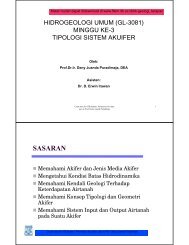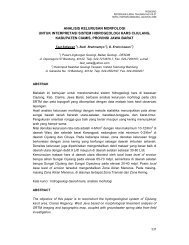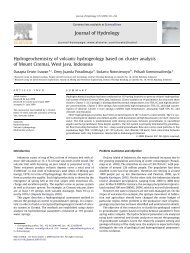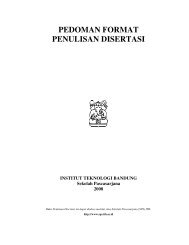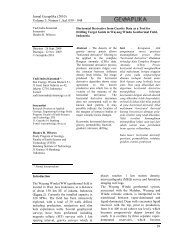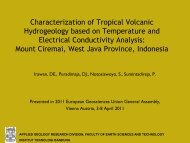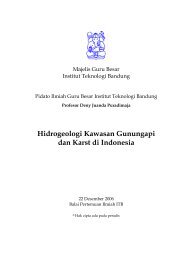Jurnal Geoaplika (2010) Volume 5, Nomor 1, hal. 049 â 059 49 - ITB
Jurnal Geoaplika (2010) Volume 5, Nomor 1, hal. 049 â 059 49 - ITB
Jurnal Geoaplika (2010) Volume 5, Nomor 1, hal. 049 â 059 49 - ITB
Create successful ePaper yourself
Turn your PDF publications into a flip-book with our unique Google optimized e-Paper software.
At CSL-07, thermal water is collected in a<br />
pond. At the bottom and wall of the pond, there<br />
is white travertine deposit. The raft travertine<br />
lithofacies (Özkul et al., 2002 classification)<br />
forms at pipe connection and at water surface<br />
mixing with organic materials. No doubt that<br />
this deposit is resulted by an active geothermal<br />
system.<br />
Quartz becomes dominant and calcite is absent<br />
in argillic alteration zone of CSL-09 and 10.<br />
Other hydrothermal minerals presenting with<br />
quartz are chlorite, smectite and kaolinite. The<br />
occurrence of clay minerals indicates that the<br />
alteration is not a surface product, but rather<br />
near surface alteration.<br />
Evolution of Geothermal System<br />
Relative concentration of Cl, Li and B as<br />
shown in Figure 5 shows that thermal waters in<br />
the study area contain more Cl relatively than<br />
Li and B. This indicates that the Cisolok (CSL-<br />
01 and 07) and Cisukarame (CRM) thermal<br />
waters are affected by volcano-magmatic<br />
activity. This is also supported by high content<br />
of F (Table 1) indicating the influence of<br />
volcanic gasses such as HCl, HF and H 2 S at<br />
sub surface. A similar ratio of B/Cl indicates<br />
that the Cisolok and Cisukarame thermal<br />
waters have a similar reservoir.<br />
Calculation of Na-K geothermometer indicates<br />
that the reservoir of Cisolok and Cisukarame<br />
thermal waters has temperature of between 190<br />
and 200C (Table 1, Figure 6). However, the<br />
reservoir temperature can be 170C as shown<br />
by Na-K-Ca geothermometer or as low as<br />
160C as reported by Priadi and Herdianita<br />
(2005).<br />
Figure 5 shows that thermal waters emerging in<br />
Cisolok have low ratio of B/Cl, Li/Cl and Li/B.<br />
This indicates that the Cisolok thermal waters<br />
flow laterally from the reservoir. Unlikely, the<br />
Cisukarame thermal water, that has higher ratio<br />
of Li/Cl than the Cisolok water, flows directly<br />
from the reservoir below as upflow zone. This<br />
evidence is supported by ratios of some solutes<br />
as mentioned in Nicholson (1993). The lateral<br />
and upflow conditions of the Cisolok –<br />
Cisukarame geothermal system is also agree<br />
with the resistivity study by Hochstein (1988)<br />
described before. In addition, both the Cisolok<br />
and Cisukarame thermal waters are not<br />
influenced by dilution of groundwater and<br />
seawater as indicated by high value of Na/K<br />
and Cl/Mg ratios, also by low TDS and Cl/SO 4<br />
ratio.<br />
Instead of spouting springs, the surface<br />
geothermal manifestation at Cisolok also<br />
consists of several surface alterations. The<br />
geothermal manifestation of Cisolok can be<br />
sketched as a cross section as shown in Figure<br />
7. By comparison the characteristics of hot<br />
spring and surface alteration, the evolution of<br />
the Cisolok geothermal system can be known.<br />
Based on the alteration pattern occurring in<br />
Cisolok, the reservoir seems to have<br />
temperature of above 220 o C indicated by the<br />
occurrence of propylitic alteration, silica sinter<br />
and travertine deposit. The chemical<br />
compositions of thermal waters and study of<br />
Hochstein (1988) indicates that the deep<br />
thermal water will flow laterally to Cisolok, but<br />
the steam will discharges directly up to<br />
Cisukarame. Steam produced from the sub<br />
surface boiling can then condense into<br />
groundwater and surface water and cause<br />
oxidation of CO 2 to H 2 CO 3 and H 2 S to H 2 SO 4 .<br />
These processes are also known as steam<br />
heating where the argillic alteration can occur.<br />
The argillic zone is dominated by kaolinite and<br />
smectite in association with chlorite and quartz,<br />
indicating that the alteration occurs at acid<br />
condition and temperatures of below 120 o C. A<br />
change in mineralogy of silica sinter from opal-<br />
A to opal-CT, perhaps into microcrystalline<br />
quartz, according to Herdianita et al. (2000),<br />
indicates that the activity of Cisolok<br />
geothermal system has been occurring more<br />
than 10,000 years.<br />
Interaction between thermal water and<br />
surrounding rocks, one of the formations is<br />
limestone, causes the deep Cl water to change<br />
into HCO 3 water. At the surface, the thermal<br />
water does not form silica sinter anymore, but<br />
travertine deposit. The travertine deposit will<br />
firstly cement the basement and alluvial<br />
materials to form pebbly travertine.<br />
Furthermore, the travertine will form<br />
crystalline crust and lithoclast above the pebbly<br />
travertine. Because the basement is dipping to<br />
SW, the travertine deposit seems to have only 1<br />
slope, i.e. dipping to SW. Point, where the hot<br />
spring emerges, is about CSL-01 to 03 now.<br />
After that, dropping of water table likely<br />
occurs. Therefore, the hot spring activity shifts<br />
54





